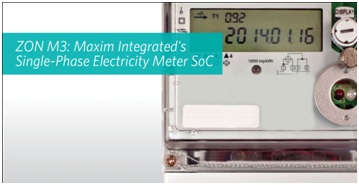Higher accuracy and low power is the need of today’s energy meter ICs. Maxim Integrated the leading semiconductor player offers intelligent solutions for today’s most advanced energy metering ICs demand globally.
Courtesy: Maxim Integrated

Maxim is a leading supplier of ICs for use in electrical energy measurement and metering. Our single-chip solutions are cost-effective and promote ease-of-design. These products are programmable to satisfy changing worldwide standards. A full suite of development tools helps speed time to market by reducing testing and prototyping time.
Maxim’s energy measurement and metering products are used in many different markets. Our products offer a full range of benefits for each of the following markets:
- Utility Infrastructure
- Data Center & IT Server Rooms
- Distribution Automation Systems
Maxim provides energy measurement and metering products that contain feature sets optimized for many applications. Learn more about products designed for the following applications:
- Utility Meters
- Embedded Measurement
Smart Meter requirements
The term “smart meter” actually encompasses a range of capabilities. The most basic meter has only remote-reading features, implemented via an RF or powerline communication (PLC) link. More advanced meters also allow the utility to provide real-time updates to users on usage and rates; the most advanced designs can provide load management—a feature that makes many end- users uncomfortable.
The smart meter market is a growth market and there is a lot of value to be gained from gathering power consumption information automatically. Utility companies worldwide have begun deploying smart meters to service residential and commercial/industrial markets. Smart meters deliver a range of benefits including lower operational and capital expenses, support for new services, and improved operational control.
Deployment of smart meters is far from a “one-size-fits-all” undertaking. Manufacturers must account for the varying regulatory requirements of each region, as well as the different functionalities and services required for different markets.
Because communications are not always reliable, some of these regulations require utilities to store two or more transmissions to meet billing requirements. This requirement increases the amount of local on-chip memory needed for smart meter ICs. As a result, the regulatory pressures of specific jurisdictions have a direct impact on the design of smart meters down to the chip level.
Another major driver of smart meter functionality is improving local antitampering capabilities. This is especially important in developing markets where electricity theft accounts for a large percentage of overall power usage. The ability of solid-state electricity meters to detect and prevent tampering can significantly improve control and cost recovery for utility companies. Here again, high-level antitampering objectives are both driving the adoption of solid-state metering and dictating required feature sets at the chip level.
Finally, the promise of improving service to customers represents an important goal of smart metering, especially over the long term. By enabling customers to better manage their own energy usage through incentive-based programs—such as direct load control, interruptible rate agreements, and demand bidding/buyback—smart metering can help utilities manage overall energy consumption patterns and cope with peak-demand challenges. With the right capabilities built into chip-level solutions, smart meter deployments can effectively lay the groundwork for expanded customer-service functions, such as wireless integration with thermostats to automatically adjust usage during peak-demand periods.
SoC Metering Solutions
It is clear from the evolving market requirements, jurisdictional regulatory differences, and varying implementation approaches that a single, universal solution is not possible. However, by using highly integrated, flexibly configurable SoC metering solutions manufacturers can bring down their R&D costs and improve their ability to serve the entire range of market requirements.
This approach also helps future proof meter architectures to meet emerging requirements.
By leveraging the flexible SoC feature set described above, manufacturers can effectively address the range of metering options—from low-cost fixed-function devices to premium devices that offer ample memory, reprogrammability, and high accuracy. As the market for smart meters continues to evolve, this flexibility will enable meter manufacturers and utility companies to adapt to the needs of customers and the dictates of regulatory authorities, while simultaneously optimizing operational efficiency and profitability.
Product at a glance: ZON M3 single phase energy meter SoC
SoC electricity meter puts emphasis on accuracy. Automotive Superior metering metrology is essential for accurate monitoring and billing. Additionally, meter manufacturers have to consider cost in their designs, as millions of meters are being deployed throughout the globe. The ZON M3 energy-meter solution integrates four 24-bit ADCs for 4-channel data collection and ±0.1% measurement accuracy over 5000:1 dynamic range. A 32-bit metrology compute engine (CE) ensures high-accuracy processing of all collected data. Its two touch-switch inputs eliminate unreliable mechanical switches by replacing with lower cost and more reliable capacitive touch sensor buttons and its infrared (IR) communications interface eliminates the typical extra IR Transceiver module. All the high integration reduces cost and improves user experience.
Key features include:
- Superior metering accuracy: over ±0.1% over 5000:1 dynamic range
- High integration: integrated touch-switch inputs and 38KHz IR Transceiver improve user experience and reduce system cost; multiple interfaces (SPI, I2C, and 4 USART) for design versatility; real-time clock (RTC) with temperature compensation and digital temperature sensor for highly accurate temperature compensation; ample Flash and RAM memory for long-term service
- High performance: Dual Core technology includes a 32-bit metrology CE ensures high-accuracy processing of all collected data, and a 32 bit MaxQ processor for metering application codes






